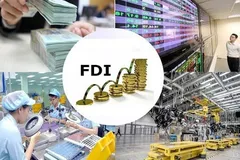
Frenzy to buy
In a report on the money market for the week 27 December to 31 December 2021, the SSI Securities Analysis Center and SSI Research said that during this time the State Bank of Vietnam net injected VND 10,540 bn through buying a 14-day term on the open market at an interest rate of 2.5% per year. In this, transactions were concentrated on the last day of the week for about VND 9,980 bn. Market analysts say that this development happened under pressure of local liquidity shortage at the end of the year.
Earlier, Saigon Investment published an article reflecting on the liquidity of the banking system at an unsettling time, with credit growth broken, reaching 12.68% as of 20 December 2021. Simultaneously, capital mobilization by credit institutions as of 24 December 2021 only increased by 8.44%. The slow pace of mobilization compared to credit was the reason when the State Bank of Vietnam was compelled to inject money.
For most of 2021, deposit interest rates maintained a downward trend because banks could not lend during the first months of the year, so there was no need to strongly absorb input capital. The twelve-month deposit interest rates had fallen to historic lows. However, since November, deposit interest rates have shown signs of increasing and by December, they increased in many banks. Therefore, in addition to borrowing from the State Bank of Vietnam in Market 2, many banks have joined the mobilizing race by increasing deposit interest rates in Market 1.
Nonetheless, the savings channel has not yet escaped from strong competition from securities and real estate channels, because banks raising interest rates by 0.3% to 0.5% have not yet created a stable base. Banks have accelerated the issuance of bonds to increase capital, and the issuance value of each batch is up to trillions of dong and the frequency is increasing.
Recently, every few days, banks have announced the issuance of bonds. For example, LienVietPostBank announced from 11 December to offer 40 million bonds, divided into two phases in fourth quarter of 2021 and first quarter of 2022, with two types of bonds with a tenor of seven years and ten years. This has total offering value at par value of VND 4,000 bn. Also in December, VietCapital Commercial Joint Stock Bank issued 25 million bonds to the public with a total par value of VND 2,500 bn with five issuances. Agribank issued 2 million bonds with a seven-year term with a total expected value of VND 2,000 bn. BIDV offered 90 million bonds with a par value of VND 100,000 per bond in two phases to mobilize VND 9,000 bn.
Stress is quite evident both in the deposit term as well as in interest rates. In the above plan, VietCapital Bank announced a fixed interest rate of upto 8.5% per year for a seven-year term in the first issuance, and the expected interest rate for the following four issues at 9% per year. LienVietPostBank announced the interest rate for seven-year bonds at 7.425% per year, for ten-year bonds at 7.725% per year.
At Agribank, the bond interest rate is 1% to 1.2% per year, higher than the average twelve-month deposit interest rate of four banks, namely, BIDV, Vietcombank, VietinBank, and Agribank, where bondholders receive interest every six months. The fact that banks not only promote capital mobilization in Markets 1 and 2, but also create big waves on the bonds market, showing that capital needs of commercial banks are very large today.
Less transparency
Compared to the task of raising capital, issuing bonds is a quick solution to many financial problems. First of all, it is necessary to mention the need to issue bonds to increase Tier 2 capital, to ensure capital adequacy ratio, because credit growth is much faster than equity growth. This is always a constant demand of banks besides increasing Tier 1 capital. In the 11 months of 2021, there were VND 46,500 bn in Tier 2 capital accounting for 27% of total issuance volume. Another reason is that banks have to restructure debt repayment terms according to Circulars issued on 01/2020, 03/2021, and 14/2021, with the value of accumulated debt extension and postponement until 20 December 2021 of about VND 607,000 bn.
In the plan to issue VND 9,000 bn in bonds, BIDV said the purpose of the issuance is to increase the size of the bank operating capital, creating more channels to attract medium and long-term capital, and meet the diverse investment needs of customers, while also ensuring the sustainability of the bank capital. The proceeds from the issuance of bonds will be used to lend to the economy for many industries such as production, electricity distribution, industry, and industrial trade. Agribank mobilizes long-term capital to meet loan demand, supplement loan capital demand for energy, agriculture, rural areas, seafood, processing, and for manufacturing industries.
The announcements on issuing bonds by banks shows that the main buyers are banks and securities companies. Statistics of the Fiin Group show that in the first nine months of 2021, banks were the main group of investors buying bonds at 56% of the total issued value. Banks that buy bonds tend to hold, while securities companies buy very strongly but then sell, mostly to secondary investors. In the first six months of 2021, securities companies have distributed about VND 70,000 bn into the market.
Most worrisome is that if banks make it a common practice to buy from each other, then there will be several expected risks in the future. The bond interest rate is getting higher and higher, while the volume of issuance is increasing, and if banks buy and sell bonds it will cause capital to flow around in the banking system and as a result the capital flow will become less transparent. The reality is that banks need money to supplement medium and long-term capital, so they have to continuously mobilize capital from Market 1, which is from bonds. However, the fact that banks own each other's bonds will make it difficult to distinguish whether banks are attracting capital to supplement medium and long-term capital for lending, or issuing bonds to meet all their capital adequacy ratios.




















